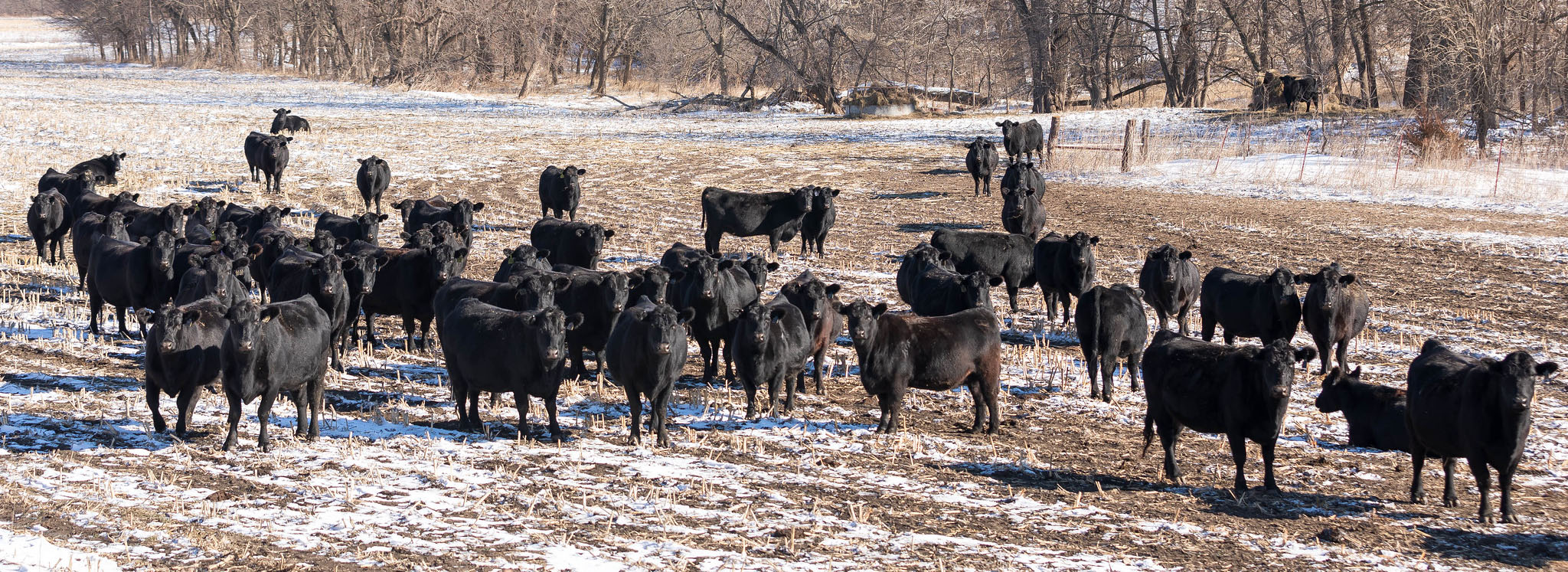
Angus cattle gather in a field. | Download photo
Cattle Chat: Preparing for winter
K-State beef cattle experts say monitoring body condition, preparing for calving and updating records are important this time of year
At a glance: K-State Beef Cattle veterinarians offer management advice for cattle care in the winter.
More information:
Todd Gunderson, 785-532-4478, tgundy@vet.k-state.edu
Phillip Lancaster, 785-532-6323, palancaster@vet.k-state.edu
Dustin Pendell, 785-532-3525, dpendell@ksu.edu
Brad White, 785-532-4243, bwhite@vet.k-state.edu
Related: Beef Cattle Institute Cattle Chat
Dec. 17, 2024
By Lisa Moser, K-State Research and Extension news service
MANHATTAN, Kan. — As people anticipate cold temperatures, many choose to winterize their homes as a way of optimizing the environment and minimizing the added expense of heating.
Just as people prepare for the winter months, the experts at the Kansas State University Beef Cattle Institute say there are things that ranchers can do to help the cattle get through the winter months.
Speaking on a recent Cattle Chat podcast, K-State beef cattle nutritionist Phillip Lancaster stressed the importance of having spring-calving cows in good body condition heading into winter.
“In really cold weather, the cow’s energy maintenance requirement can increase from 20-40%, so it is important to increase the caloric intake of cows that are too thin,” Lancaster said.
He said it is also important that cattle have access to water.
“Make sure you routinely check the (farm’s) water sources to make sure they aren’t frozen over so that cattle can drink the water,” Lancaster said.
For ranchers who calve in the winter months, it is important to monitor the weather and be able to get the newborns to a warm and dry place when the temperature drops and moisture sets in, K-State veterinarian Todd Gunderson said.
“Once the temperatures get into the teens, producers need to worry about the newborn calves experiencing frostbite, especially on their ears and tails,” he said.
K-State veterinarian Brad White agreed and added, “Cold and wet conditions can lead to negative health outcomes as opposed to those that are born in a cold, but dry environment.”
To keep the calves dry, some producers will move the cows to a calving barn, according to Gunderson, who stressed the importance of sanitation and fresh bedding to reduce the spread of disease.
“It is important to keep calves that are in the first 24 to 48 hours of their life in a warm and dry environment and then move them out of the barn to reduce the risk for contamination and disease transmission,” he said.
The K-State experts also recommend that producers update their ranch’s year-end records.
“When it is too cold to be outside, that is a great time to get the records updated on the computer and do some review of how the herd performed in the last year,” K-State agricultural economist Dustin Pendell said. “You can look at the data and think about what you did well and areas to improve upon in the year ahead.”
To hear the full discussion, listen to Cattle Chat on your preferred streaming platform.
***

K‑State Research and Extension is a short name for the Kansas State University Agricultural Experiment Station and Cooperative Extension Service, a program designed to generate and distribute useful knowledge for the well‑being of Kansans. Supported by county, state, federal and private funds, the program has county extension offices, experiment fields, area extension offices and regional research centers statewide. Its headquarters is on the K‑State campus in Manhattan. For more information, visit www.ksre.ksu.edu. K-State Research and Extension is an equal opportunity provider and employer.